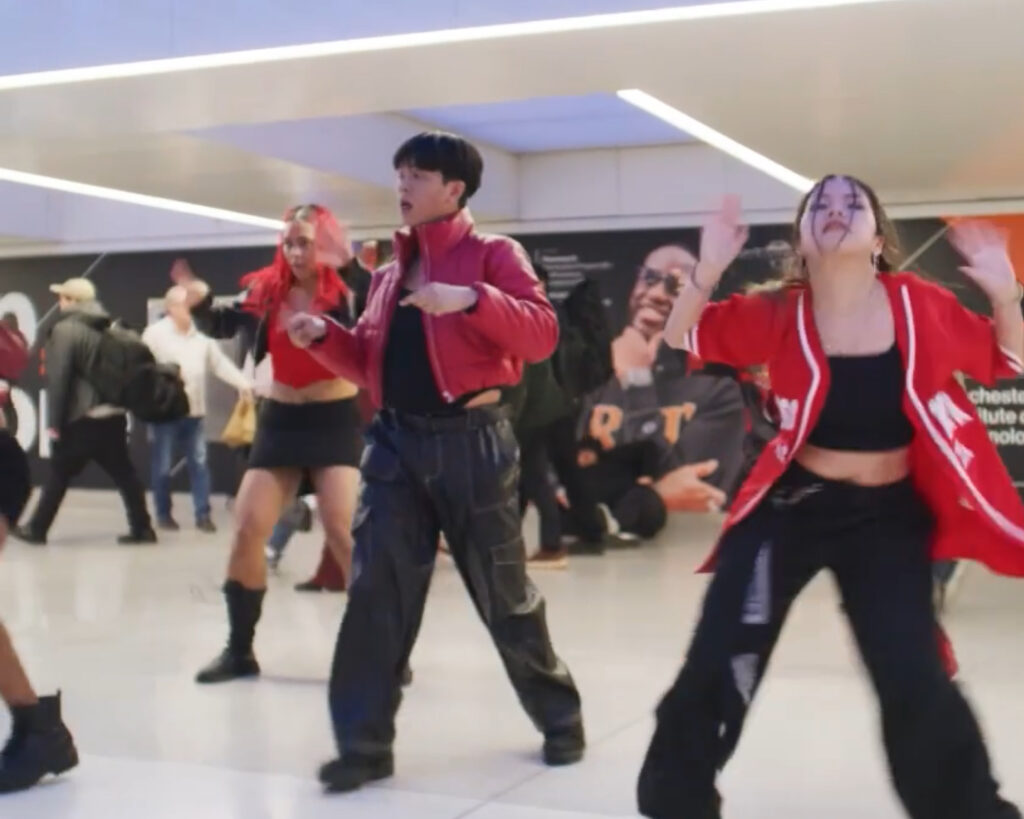On any given afternoon, beneath the busy crosscurrents of commuters and tourists spilling through Manhattan’s Penn Station, a parallel world begins to unfold—one of rhythm, dedication, and quiet rebellion. Here, in the lower level of Moynihan Train Hall, smooth terrazzo floors, echoing ceilings, and convenient public restrooms have created an unlikely sanctuary: New York’s unofficial, unregulated, open-air dance studio.
What was meant to be nothing more than a modernized pedestrian connector—practical, functional, barely noticed—is now transformed daily into a stage. K-pop dancers drill high-intensity routines, spinning and locking to the electronic pulse of Korean pop. Salsa couples, some in everyday sneakers, others in soft, worn-out ballroom shoes, glide across the space with dramatic flair. Brazilian Zouk dancers weave intricate, intimate patterns, their fluid torsos and rapid footwork creating the illusion of water flowing across the marble.
There are no mirrors, no ticket sales, no velvet ropes. Only the steady presence of people reclaiming urban space—not for profit or performance, but for practice, community, and expression. This unspoken takeover has become, in its own way, one of the most authentic reflections of New York’s spirit today: improvisational, inclusive, and profoundly alive.
The Accidental Dance Hall
Moynihan Hall, which opened in early 2021 as part of an ambitious plan to reimagine Penn Station, was meant to evoke grandeur—a civic cathedral of steel and light to soothe the chaos of midtown commuting. And in many ways, it succeeded. The Art Deco clocks, soaring glass ceilings, and white marble expanses promised to humanize the grim reputation of the original Penn Station’s crowded corridors. Yet it is precisely this humane design—the generous, open spaces, the sense of lightness and movement—that also made Moynihan fertile ground for another kind of movement altogether.
Most weekday afternoons, as the commuter rush ebbs into a quieter flow, young dancers arrive with backpacks, Bluetooth speakers, and an understated sense of purpose. They claim their small patches of floor space without formal permission, forming loose circles or discrete practice groups. There’s a mutual understanding: speakers at a moderate volume, no monopolizing too much room, and a general readiness to apologize if a collision occurs.
In a city notorious for the cost of studio rentals—where rehearsal spaces can charge upwards of $30-$50 an hour—Moynihan offers something rare: free, accessible, public floor space. In a way, it echoes the old adage about New York itself: if you can find your place here, even for a few hours, it’s yours.
K-Pop Colonizers
The largest and most visible of Moynihan’s dancers are the K-pop enthusiasts. On any given day, you might find a cluster of teenagers and twenty-somethings mirroring the hyper-precise choreography of BTS, BLACKPINK, NewJeans, or Stray Kids. Clad in black hoodies, cargo pants, and often sporting earbuds even as they perform publicly, they treat the station floor with a reverence normally reserved for professional studios.
Their routines are sharp, kinetic, and demanding—synchronized to the millisecond. Occasionally, you’ll catch the flicker of frustration when a turn is mistimed or a hand position falters. But more often, the atmosphere is one of camaraderie: a new friend adjusting a wrist angle; an older dancer offering a corrective tap on the shoulder; shy smiles when strangers stop to watch or offer quiet applause.
It’s fitting, perhaps, that a genre so rooted in spectacle, perfectionism, and relentless training should find its home not on a polished stage but in the imperfect embrace of public infrastructure. Here, the dancers rehearse not for fame or followers, but for mastery itself.
Salsa’s Second Home
The K-pop crews may dominate the visual landscape, but on weekend afternoons, another rhythm asserts itself. Salsa dancers, drawn from a broad diaspora of Latinx New Yorkers, claim a corner of the hall and bring an entirely different energy.
Salsa at Moynihan is louder, more communal. Bluetooth speakers pump out brassy horn sections and conga beats; spontaneous whoops and shouts punctuate the air. Unlike the precision-driven K-pop routines, salsa here emphasizes flow, connection, improvisation. Partners swap out mid-song. Beginners stumble and laugh. Experts spin faster and dip deeper, attracting little clusters of onlookers who tap their feet along the margins.
Many of these dancers first encountered salsa at social nights in Brooklyn or Queens. Others are older veterans who once danced in the legendary Copacabana or the late, great Gonzalez y Gonzalez downtown. For them, Moynihan is both a training ground and a tribute—a place to pass on the culture to the next generation, one basic step at a time.
Zouk’s Whisper
Then there are the Brazilian Zouk dancers—a smaller, quieter contingent, often tucked away in a corner less visible to casual passersby. Zouk, with its close body contact and hypnotic head rolls, is less about external spectacle and more about internal connection. It requires trust between partners, a willingness to surrender to the moment, the music, and each other.
Watching two Zouk dancers in Moynihan can feel almost voyeuristic, like intruding on a conversation spoken entirely in touch. And yet, they, too, have found a place here—tolerated by the station’s private security, occasionally joined by curious strangers willing to learn.
For these dancers, Moynihan is a laboratory of intimacy in a city built on anonymity. In a metropolis where human connection can feel impossibly distant, they create small pockets of profound closeness, just steps from the Acela Lounge and the Dunkin’ counter.
Dance as Civic Occupation
The existence of this unofficial dance hall speaks to a deeper truth about public spaces in New York: they are never truly public unless they are used, reshaped, reimagined by the people themselves. Dance in Moynihan is not sanctioned, curated, or monetized. It is spontaneous civic occupation—a reminder that public architecture must serve the organic needs of its citizens, not just the aesthetic ambitions of its designers.
It is tempting to romanticize this scene, to view it as evidence that “art finds a way” even in the harshest urban environments. But it’s important to recognize that it exists precisely because of a scarcity elsewhere. Affordable rehearsal space is almost nonexistent for the city’s independent dancers. Traditional public spaces like parks are not always practical for detailed choreography. Subway platforms and sidewalks are too chaotic, too dangerous.
Moynihan’s lower level became the people’s studio not because it was designed to be one, but because dancers had nowhere else to go—and because New Yorkers, in their endless, restless creativity, will always find a way to carve out room for their passions.
The Audience That Never Bought a Ticket
One of the most remarkable aspects of the Moynihan dance scene is its relationship with its accidental audience. Commuters, tourists, and Amtrak travelers pass by the dancers, sometimes slowing down to watch, sometimes ignoring them entirely. There’s a mutual understanding: the performers demand no applause, and the passersby owe none. Yet when a particularly stunning move lands—a perfect backflip, a seamless multiple spin—you’ll often see a few strangers stop, applaud, or offer a shouted “You got this!”
This dynamic creates a democratized performance space where participation is entirely voluntary. No one is selling anything. No one is asking for donations. The audience chooses whether to engage or to pass by, and both choices are equally respected.
In a city where art is often commodified beyond recognition—gallery openings with $20 entry fees, “immersive experiences” costing hundreds of dollars—this free, fleeting exchange between dancer and viewer feels revolutionary.
The Fragility of an Unofficial Utopia
Of course, the unofficial nature of this dance hall also makes it precarious. Already, signs of encroachment are visible: periodic sweeps by security guards asking dancers to move along, increasing signage reminding visitors that “No Loitering” is allowed.
As Moynihan continues to evolve—adding high-end retail, upscale dining, and ticketed events—it is not hard to imagine a future in which these dancers are seen not as colorful footnotes but as liabilities, obstacles to be cleared away for a “better customer experience.”
Yet for now, they endure. And in enduring, they offer a blueprint for what urban public life can be at its best: creative, chaotic, communal, and utterly uncontainable.
A Final Twirl
In the shadow of New York’s towering ambition—in the grand hallways built for billion-dollar trains and intercity travel—something humble and human persists.
A teenage boy perfecting his popping routine. A middle-aged woman teaching her niece the basic salsa step. Two strangers locking eyes over a shared love of dance, spinning and laughing in a cathedral of marble and light.
Here, beneath the steel beams and sweeping arches, the city dances not for money, fame, or Instagram likes, but for the oldest reason of all: because it must. Because movement is life, and life—despite everything—insists on breaking through.
And so, every day, while Penn Station carries thousands toward their destinations, a different kind of journey unfolds just below: improvised, embodied, defiantly free.
In this subterranean ballet, the city remembers itself—not as a place of hustle and transaction, but as a living, breathing, dancing thing.
No comments yet.








